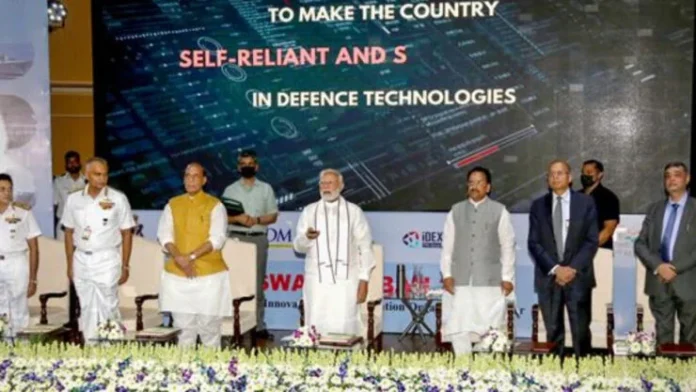New Delhi: Having a long coast line of about 7,516.6 km bordering the mainland and the islands with the Bay of Bengal in the East, the Indian Ocean on the South and the Arabian Sea on the West covering nine states and four union territories (UTs), the oceans and coasts play a major role in the nation’s economy.
As Prime Minister Narendra Modi told a two-day seminar organised by Naval Innovation and Indigenisation Organisation (NIIO) and the Society of Indian Defence Manufacturers (SIDM) “SPRINT Challenges”, the role of the Indian Navy is continuously increasing and therefore its self-reliance is of critical importance.
In keeping with the Prime Minister’s focus on “Atmanirbhar Bharat,” the Navy has been ramping up indigenisation efforts especially in weapons and aviation related items to cut down on defence imports and boost domestic manufacturing. Indigenisation efforts gained further urgency due to ongoing Russia-Ukraine conflict and the large scale dependency of Indian military on Russian arms and equipment. As part of the government efforts to boost indigenization in the defence sector, the Ministry of Defence (MoD) released the third positive indigenisation list of 101 items, comprising major equipment and platforms.
The Navy has been focusing on indigenisation and as part of this, it had in 2014 promulgated the Indian Navy Indigenisation Plan (INIP) 2015-2030 to enable indigenous development of equipment and system. Till date, the Navy has indigenised around 3400 items under INIP, including over 2000 machinery and electrical spares, over 1000 aviation spares and over 250 weapon spares. The existing Naval Aviation Indigenisation Roadmap (NAIR) 2019-22 is also under revision.
All fast moving aircraft mandatory spares and high cost indigenous repairs are being included in the revised NAIR 2022-27. There is particular focus on the fight component (which is weapons) as there is still a long way to go compared to the float and move components. Four in-house indigenisation committees have been formed to handle indigenisation of spares with respect to naval aircraft. In addition, the Naval Liaison Cells (NLCs) located at various places have been nominated as ‘indigenisation cells’.
There are currently 41 ships and submarines under construction, 39 are being built in Indian shipyards while in principle approval from MoD exists for 47 ships to be built in India. Since 2014, 78 % of Acceptance of Necessity (AoN), by value, and 68 % of contracts, by value, have been awarded to Indian vendors.
As part of the indigenisation effort, the Navy is working with the Defence Research and Development Organisation (DRDO) and the industry to cut down developmental timelines. Some of the focus areas include indigenous design and development and production of Anti-Submarine Weapons and sensors, Satcom and electronic warfare equipment, Anti-Ship Missiles and Medium Range Surface to Air Missile, combat management system, software defined radios, network encryption devices, Link II communication system, main batteries for submarines, distress sonar system, components of missiles and torpedoes.
The Naval Innovation and Indigenisation Organisation (NIIO) which was one of the organisers of the seminar was launched in August 2020, and it provides a flexible and accessible interface for academia and industry with Indian Navy capability development apparatus. In the last two years, 36 Intellectual Property Rights(IPR) applications have been filed by Navy personnel. Over two IPR applications are filed every month since the creation of NIIO and Transfer of Technology to 12 Micro, Small and Medium-sized Enterprises (MSMEs) has already been undertaken. The Navy has now forward deployed user inputs through Naval Project Management Teams at cluster Headquarters of DRDO and two such clusters are already operational. These have interfaced with the DRDO labs and their Development cum Production Partners (DcPP) to provide user inputs at every stage to 15 futuristic Technology and 100 plus DRDO projects underway for development of Indian Navy’s combat capability.
Unveiling the “SPRINT Challenges,” Prime Minister Modi said, “Innovation is critical and it has to be indigenous. Imported goods can’t be a source of innovation.” Stressing the need for a change in mind set of attraction for imported goods, he added, “We have to work to continuously increase the number of indigenous technologies. Your goal should be that when India celebrates 100 years of its Independence, at that time our Navy should be at an unprecedented height.”
In order to achieve self-reliance in the defence industry, the seminar involved Indian academia and industry and it provided leaders from business, academia, services, and government a forum to collaborate on ideas and formulate suggestions for the defence sector. There were sessions on innovation, indigenization, armament, and aviation. The seminar also focused on the government’s SAGAR (Security and Growth for All in the Region).
The Sagarmala plan for port-led development this year saw an addition of 735 projects, taking the total pipeline to 1537 projects at a cost of Rs 6.5 trillion, the minister of ports, shipping, and waterways Sarbananda Sonowal had said. After a meeting of the National Sagarmala Apex Committee (NSAC), the core panel overseeing the maritime project, he announced that the government will undertake projects worth Rs 58,700 crore for development of coastal districts across the country.
“While Sagarmala is port-led and focuses on reduction in the cost of logistics and EXIM (export-import) competitiveness, holistic development of coastal districts aims to bridge gaps in infrastructure and create economic opportunities,” the minister said.
The government is also adding 168 other projects for development, with a cost estimate to the tune of Rs 50,000 crore, with the ministry’s focus on pubic private partnership (PPP) projects. A total of 29 projects worth Rs. 45,000 Crore have been successfully implemented under PPP model, and additional 32 PPP projects worth Rs 51,000 Crore are currently being implemented, Sonowal said. The net additional cost of the maritime plan is Rs one trillion now.
As part of the government’s efforts to boost maritime sector, the prime minister made a strong pitch with Nordic companies asking them to invest in the Sagarmala Project and Blue economy sector, and further also sought investments from the sovereign wealth funds of the Nordic countries. It is important to note that as part of the Sagarmala project, a total of 800 projects of an estimated cost of around Rs 5.48 lakh crore are to be taken up for implementation. Sagarmala projects include projects from various categories such as modernisation of existing ports and terminals, new ports, terminals, inland waterways, lighthouse tourism and skill development.
– The writer is a senior journalist and media consultant. The views expressed are of the writer and do not necessarily reflect the views of Raksha Anirveda.






